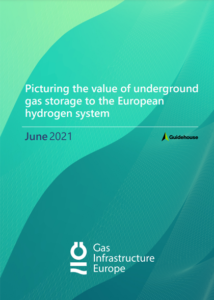- Our DNA
- Innovation Lab
- Publications
- Energy Transparency
- Press Corner
- Events
- Contact
- Subscribe
- Membernet
- My account
- Search
- Follow us at LinkedIn
- Follow us on Twitter
- Follow us on Instagram
June 15, 2021
The study presents the essential role of underground gas storages in establishing an integrated energy system and hydrogen economy in Europe by 2050. The vision paper and map provide a detailed overview, with concrete facts and figures, of the potential of these facilities. They build on the updated proposal for the European Hydrogen Backbone (EHB), a vision for a pan-European dedicated hydrogen network. This analysis was performed by Guidehouse in collaboration with GIE.

“It was positive to see the European Commission recognising the needs for underground hydrogen storages in its Hydrogen Strategy in July 2020. Within GIE, we are deeply convinced they will play a vital part in balancing the future energy system that relies significantly on renewable energy sources.” Boyana Achovski, GIE Secretary General
“The task of storing energy on a large scale is not new. However, the role of gas storage is expected to be even more pronounced due to the higher penetration of intermittent energy sources into our energy system. With this study, we wanted to look in more detail and raise awareness on the way underground hydrogen storages will ensure energy resilience and contribute to securing Europe’s leadership on the hydrogen market, at the lowest cost to society.” Dr Axel Wietfeld, GSE President
Here is a foretaste of what you will learn from this study: on the supply side, the need for large-scale storage could be explained by higher hydrogen supply variability driven by intermittent renewable electricity production. On the demand side, this is because of the increase in electrification and the subsequent need to meet higher electricity demand peaks created by residual load.
“When it comes to reaching the European Union’s carbon neutrality objective, the assets of GIE members – Storage, Transmission and LNG Terminals System Operators – will all be part of the solution. That’s why we extend the EHB’s vision by providing an initial outlook into the hydrogen storage needs across Europe, in terms of capacities and services, as well as a broader discussion on repurposing and retrofitting possibilities, geographical availability, and the type of flexibility required in the future markets.” Torben Brabo, GIE President
“To prepare the ground for investment and political decisions, transparency is key and we have all the right tools to deliver that to the EU stakeholders and citizens. The data we collect and make available for further analyses and studies is the latest and most accurate from the industry. We will continue to deliver the right and most reliable figures in support for the best decisions.” Francisco de la Flor, GIE System Operations & Development Area Sponsor
For an effective decarbonisation of the European economy, here is what we need:
Download the study at : https://www.gie.eu/publications/studies/
Related materials :
GIE Press Release
Press Release, 15 June 2021
European Commission Hydrogen Strategy
A hydrogen strategy for a climate-neutral Europe
Presentation of the Study at European Hydrogen Webinar, 15 June 2021
Full event video recording (1h28)
Extending the European Hydrogen Backbone
Gas for Climate Vision report
Gas Infrastructure Europe (GIE) is the association representing the interests of European gas infrastructure operators active in gas transmission, gas storage and Liquefied Natural Gas (LNG) regasification. GIE is a trusted partner of European institutions, regulatory bodies and industry stakeholders. It is based in Brussels, the heart of European policymaking. GIE currently represents 70 member companies from 26 countries. GIE’s vision is that by 2050, the gas infrastructure will be the backbone of the new innovative energy system, allowing European citizens to benefit from a secure, efficient and sustainable energy supply.





































































